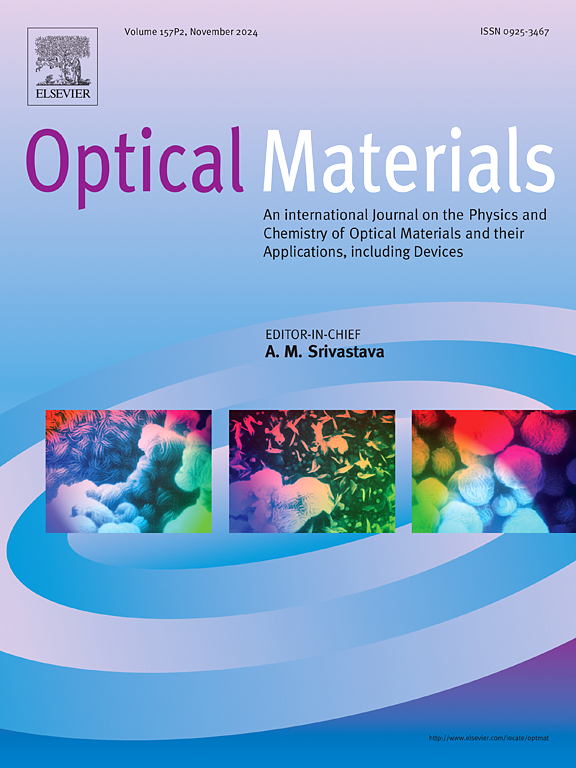基于上转换纳米粒子NaGdF4:Yb3+,Er3+@ZIF-8的发光温度计
IF 4.2
3区 材料科学
Q2 MATERIALS SCIENCE, MULTIDISCIPLINARY
引用次数: 0
摘要
采用水热法制备了一种上转换发光纳米温度计,其平均尺寸约为289.5 nm,多分散性指数为24.85%。合成的NaGdF4:Yb3+,Er3+@ZIF-8纳米粒子在第一和第二生物窗(NIR-I和NIR-II)激发下在可见光和近红外区均表现出上转换发光。此外,NIR-I和NIR-II区的激发可以用来调节NaGdF4:Yb3+,Er3+@ZIF-8纳米粒子的上转换和下移发射。温度相关的上转换发光测量显示,在83-743 K的宽温度范围内,热响应令人满意。在123 K下获得的最大相对灵敏度为3.08% K−1,是裸核α-NaGdF4:Yb3+,Er3+纳米粒子的5.1倍。紫外可见光谱进一步证实了在合成的核壳上存在咪唑类化合物的特异键NaGdF4:Yb3+,Er3+@ZIF-8。此外,在不同位置记录的TEM/HRTEM图像和SAED图证实了α-NaGdF4:Yb3+,Er3+核纳米颗粒表面存在ZIF-8壳层。本文章由计算机程序翻译,如有差异,请以英文原文为准。
The luminescence thermometer based on up-converting NaGdF4:Yb3+,Er3+@ZIF-8 nanoparticles
An upconversion luminescence nanothermometer based on NaGdF4:Yb3+,Er3+@ZIF-8 nanoparticles, with an average size of approximately 289.5 nm and a polydispersity index of 24.85 %, was successfully synthesized via a hydrothermal route. The as-synthesized NaGdF4:Yb3+,Er3+@ZIF-8 nanoparticles exhibit upconversion luminescence in both the visible and near-infrared regions under excitation within the first and second biological windows (NIR-I and NIR-II). Moreover, excitation in the NIR-I and NIR-II regions can be utilized to modulate the upconversion and downshifting emission of the NaGdF4:Yb3+,Er3+@ZIF-8 nanoparticles. Temperature-dependent upconversion luminescence measurements revealed a satisfactory thermal response over a wide temperature range of 83–743 K. The maximum relative sensitivity achieved was 3.08 % K−1 at 123 K, which is 5.1 times higher than that of the bare core α-NaGdF4:Yb3+,Er3+ nanoparticles. The UV-VIS spectrum further confirmed the presence of the specific bonds of imidazole compounds on the synthesized core/shell NaGdF4:Yb3+,Er3+@ZIF-8. Additionally, TEM/HRTEM images and SAED patterns recorded at different locations verified the presence of ZIF-8 shell layers on the surface of the α-NaGdF4:Yb3+,Er3+ core nanoparticles.
求助全文
通过发布文献求助,成功后即可免费获取论文全文。
去求助
来源期刊

Optical Materials
工程技术-材料科学:综合
CiteScore
6.60
自引率
12.80%
发文量
1265
审稿时长
38 days
期刊介绍:
Optical Materials has an open access mirror journal Optical Materials: X, sharing the same aims and scope, editorial team, submission system and rigorous peer review.
The purpose of Optical Materials is to provide a means of communication and technology transfer between researchers who are interested in materials for potential device applications. The journal publishes original papers and review articles on the design, synthesis, characterisation and applications of optical materials.
OPTICAL MATERIALS focuses on:
• Optical Properties of Material Systems;
• The Materials Aspects of Optical Phenomena;
• The Materials Aspects of Devices and Applications.
Authors can submit separate research elements describing their data to Data in Brief and methods to Methods X.
 求助内容:
求助内容: 应助结果提醒方式:
应助结果提醒方式:


